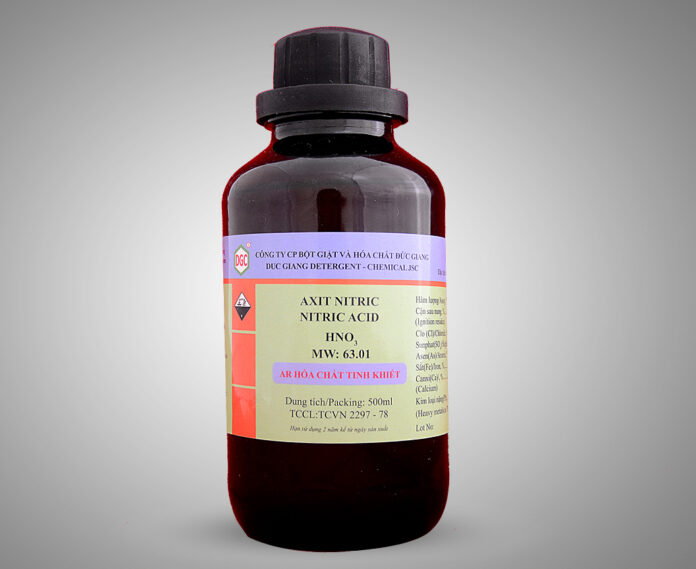If you look at the periodic table, at position 7, you’ll find nitrogen (N). Nitrogen is fascinating because it plays many roles, including being an essential component of living organisms, making up 78% of the Earth’s atmosphere. At the same time, in the form of the inorganic acid HNO3 (nitric acid), it can become a toxic substance and a powerful poison. Therefore, caution is required when handling it.
Interesting Facts:
- Nitric acid is a transparent liquid, but under certain conditions, it can turn yellow, such as when interacting with proteins, or take on a brown hue when heated or exposed to direct sunlight.
- At normal atmospheric pressure, nitric acid boils at +82.6°C (180.7°F) and solidifies into crystals at -42°C (-43.6°F).
- The first person credited with discovering nitric acid was the Arab chemist Jabir ibn Hayyan (Geber). However, despite his experiments, he could not obtain it in high concentration.
- Until the mid-20th century, HNO3 was colloquially called “strong water,” though it had nothing to do with alcoholic beverages.
- Concentrated nitric acid (over 85%) starts to smoke intensely upon contact with air. Inhalation can lead to severe poisoning and burns on the mucous membranes.
- This chemical compound is easily recognizable by its sharp smell, though sniffing it is strongly discouraged due to its toxic properties.
- Nitric acid dissolves all metals except for gold, tantalum, and those in the platinum group. This dissolving property can be neutralized by adding HCl in the correct proportion.
- Amines can spontaneously ignite when in contact with nitric acid.
- Nitric acid is unstable. When heated, it decomposes into water and nitrogen dioxide. To prevent this, it should be stored as a solution.
- Nitric acid was widely used by alchemists in their quest to find the “philosopher’s stone.”
- HNO3 is a strong electrolyte.
- Nitric acid is 1.5 times heavier than water due to its higher density.
- Most pyrotechnics, including fireworks, contain this chemical compound.
- Modern industries heavily rely on nitric acid for a variety of purposes, including the production of explosives, rocket fuel, plastics, and for testing the purity of precious metals.
- Nitric acid is also used in medicine, especially in dentistry and for treating skin conditions, like burning off warts.
- HNO3 is a key component of many mineral fertilizers, essential for agriculture. However, it must be used in the correct amounts. If overused, fruits and vegetables can accumulate harmful nitrates, making them unsafe to eat.
- An attempt to create a glowing substance by mixing nitric acid and chalk helped German physicist Johann Schulze in 1725 discover that silver darkens when exposed to sunlight.
- Safety regulations for working with nitric acid require workers to wear specialized protective gear, including shoes, gloves, coveralls, goggles, and respirators.
